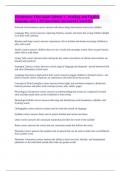Elementary Education Subtest 1 - reading and English
language arts || All Questions Answered Correctly.
Informal Conversations correct answers talk about things that interest and excite children
Language Play correct answers exploring rhythms, sounds, and tones that young children delight
in as they work and play
Rhymes and Song correct answers experiences rich in rhythm and rhyme encourage children to
play with words
Stories correct answers children discover new words and meanings as they listen to good stories,
either told or read aloud
Group Talk correct answers times during the day when conventions of shared conversations are
learned and practiced
Emergent Literacy correct answers critical stage of language development - period between birth
and early elementary school years
Language Experience Approach (LEA) correct answers engage children in dictated stories - ask
them to dictate stories, responses, or experiences and write down the account
Concepts of Print Examples correct answers left-to-right, top-to-bottom sequence, distinction
between pictures and print, book concepts (cover, title, author, page)
Phonological Awareness correct answers an understanding that words are composed of sound
units and that sound units can be combined to form words
Phonological Skills correct answers detecting and identifying word boundaries, syllables, and
rhyming words
Orthography correct answers system used to write the sounds of language
Syllable correct answers basic unit of speech divided into onsets and rimes
Onset correct answers the consonant sound that precedes the vowel of the syllable
Rime correct answers the vowel and any consonant sound that follows the onset
Phoneme correct answers the smallest unit of speech that can be used to make one word different
from another word
Phonemic Awareness correct answers the ability to focus on, hear, identify, and manipulated
phonemes or the individual sounds that make up spoken words
,Phoneme Segmentation correct answers a child's ability to recognize the separate sound units of
words
Phoneme Blending correct answers a child's ability to string together phonemes in a meaningful
way to create words
Phoneme Isolation correct answers recognizing the individual sounds in words - first sound in
word top /t/
Phoneme Identity correct answers recognizing the common sound in different words - same
sound in pig, pot, and pie /p/
Phoneme Substitution correct answers turning one word into another by substituting one
phoneme for another - initial sound (top-mop), middle sound (top-tap), ending sounds (top-tot)
Oral Segmentation correct answers identifying the individual sounds of a word - top is composed
of phonemes /t/, /o/, and /p/
Oral Blending correct answers being able to blend phonemes into words - give phonemes /t/, /o/,
and /p/ and child says top
Phoneme Deletion correct answers being able to identify a sound that has been deleted from a
word - teacher has child say top then repeat the word leaving out one of its sounds
Concepts of Print correct answers term used to characterize the knowledge that emergent readers
have about how printed language works and how print can be used to represent language
Literacy Conventions correct answers hold book correctly, turn pages right to left, know where
to begin on page, move eyes left to right, pages read top to bottom, understand books have a
front and back
Teachers promote emergent reading skills by: correct answers model what readers do when they
read aloud, point to words as they read, explain what the punctuation is for, anchorage student
participation
Alphabetic Principle correct answers the idea that written letters and letter patterns can be used
to represent speech sounds
The tools of communication children use to form their understanding of the word correct answers
reading, writing, listening, and speaking
Competency 1 correct answers demonstrate an understanding of the foundations of language
development, oral language skills, listening and comprehension skills, and phonological and
phonemic awareness
, Because this entire period between birth an the early elementary school years help prepare
children with the skills important for conventional literacy, we refer to this critical stage of
language development as ___ ___ correct answers Emergent Literacy
The key is to make reading and writing ___ to the everyday life of the classroom and to make
literacy activities ___ to each child. correct answers fundamental, relevant
___ and ___ to what the children have to say and they will learn to do the same. correct answers
Listen, respond
LEA correct answers Language Experience Approach
Alliteration correct answers use of the same consonant at the beginning of each stressed syllable
in a line of verse
Language Delay correct answers Common conditions: inadequate language stimulation, delayed
general development, parents/guardians who talk for the child, medical/physical problems,
family history of language delay, learning disabilities, autism spectrum disorders ASD
ASD correct answers Autism Spectrum Disorders
Listening can be described as part of an active communication process that involves ___, ___,
and ___ to verbal input. correct answers receiving, interpreting, responding
The three steps in the listening process are ___, ___, and ___ meaning. correct answers
receiving, attending, and assigning (meaning)
Students can be given opportunities to develop and practice listening skills during three phases of
the listening process: ___, ___, and ___. correct answers pre-listening, during listening, after
listening
Discriminative Listening correct answers distinguishing beginning consonant sounds, for
example
Aesthetic Listening correct answers for enjoyment
Critical Listening correct answers to evaluate a message
Efferent Listengin correct answers to understand a message
Phonology correct answers the study of the sound system of a given language and the analysis
and classification of its phonemes
Phoneme correct answers (linguistics) one of a small set of speech sounds that are distinguished
by the speakers of a particular language




